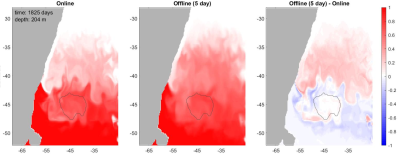FEOTS: A Novel Tool for Calculating Tracer Distributions in the Ocean
Many ocean circulation problems can be addressed by simulating tracers that do not affect the ocean circulation, for instance, the simulation of marine biogeochemical cycles, or of dye tracers that reveal water mass pathways and mixing. Transport Matrix Models (TMMs) are a class of models that can simulate tracer transport using transport operators that were diagnosed from comprehensive ocean models, hence putting computational resources towards simulating tracers, and not the circulation. To date, TTMs have been used uniquely for low-resolution climate models, limiting their use for tracer transport problems that depend sensitively on the mesoscale eddy field. We developed a new software package called Fast Equilibration of Ocean Tracers Software (FEOTS) to enable offline tracer calculations using transport operators from eddy-permitting ocean models. FEOTS is written in Fortran and can run efficiently on supercomputers and take advantage of modern algorithmic developments. We apply FEOTS to a challenging problem, namely tracer transport in an eddy-dominated part of the ocean, namely the Argentine Basin. Even though the comparison between online and offline simulations is not perfect, due to some technical challenges associated with the advective operator in the parent model POP, we demonstrate that TMMs in general, and FEOTS in particular, has significant potential to efficiently calculate tracer distributions in an eddying ocean model.
Simulating passive tracers (tracers that do not affect circulation) with full-blown global GCMs is expensive. Transport Matrix Models (TMMs) are a promising methodology to simulate tracers using transport operators diagnosed from a comprehensive ocean climate model. However, so far TMMs have been applied to low-resolution models only, limiting their usefulness for regions that are dominated by eddies, like the Argentine Basin. For the first time, we apply a TMM to calculate tracer distributions in an eddying ocean model.
In this paper, we introduce a new software framework for the offline calculation of tracer transport in the ocean. The Fast Equilibration of Ocean Tracers Software (FEOTS) is an end-to-end set of tools to efficiently calculate tracer distributions on a global or regional sub-domain using transport operators diagnosed from a comprehensive ocean model. To the best of our knowledge, this is the first application of a transport matrix model to an eddying ocean state. While a Newton–Krylov-based equilibration capability is still under development and not presented here, we demonstrate in this paper the transient modeling capabilities of FEOTS in an application focused on the Argentine Basin, where intense eddy activity and the Zapiola Anticyclone lead to strong mixing of water masses. The demonstration illustrates progress in developing offline passive tracer simulation capabilities while highlighting the challenges of the impulse response functions approach in capturing tracer transports by a non-linear advection scheme.

